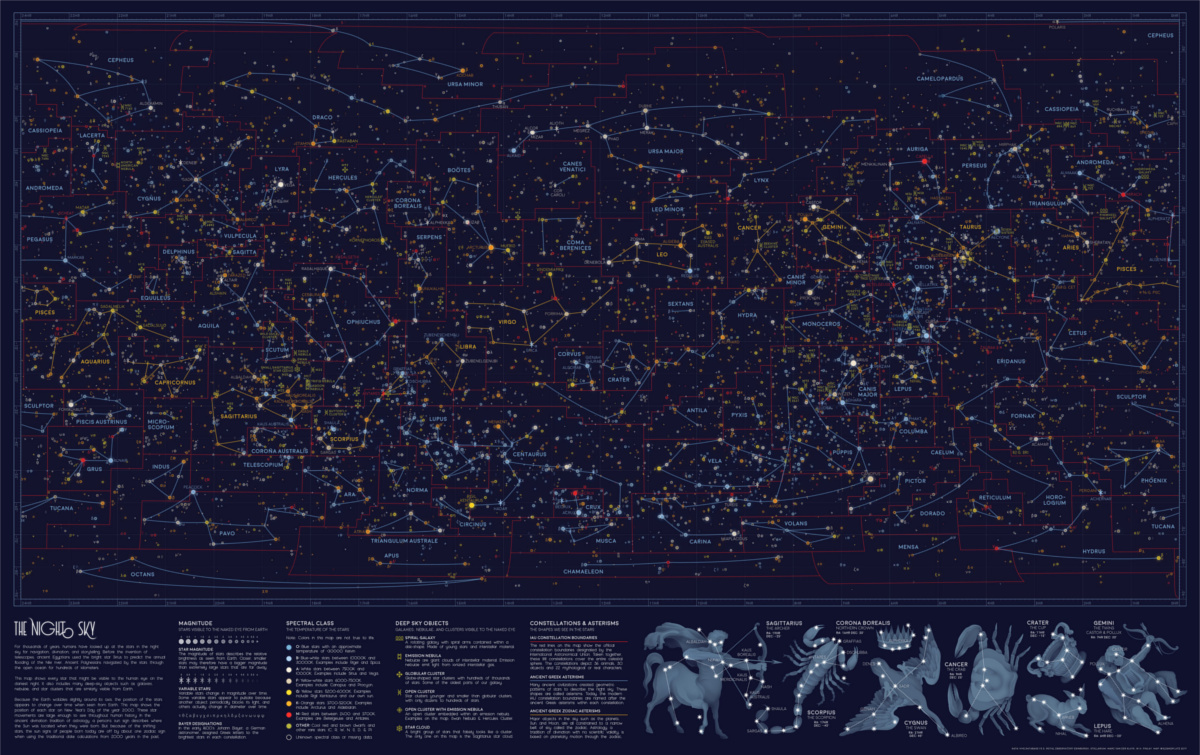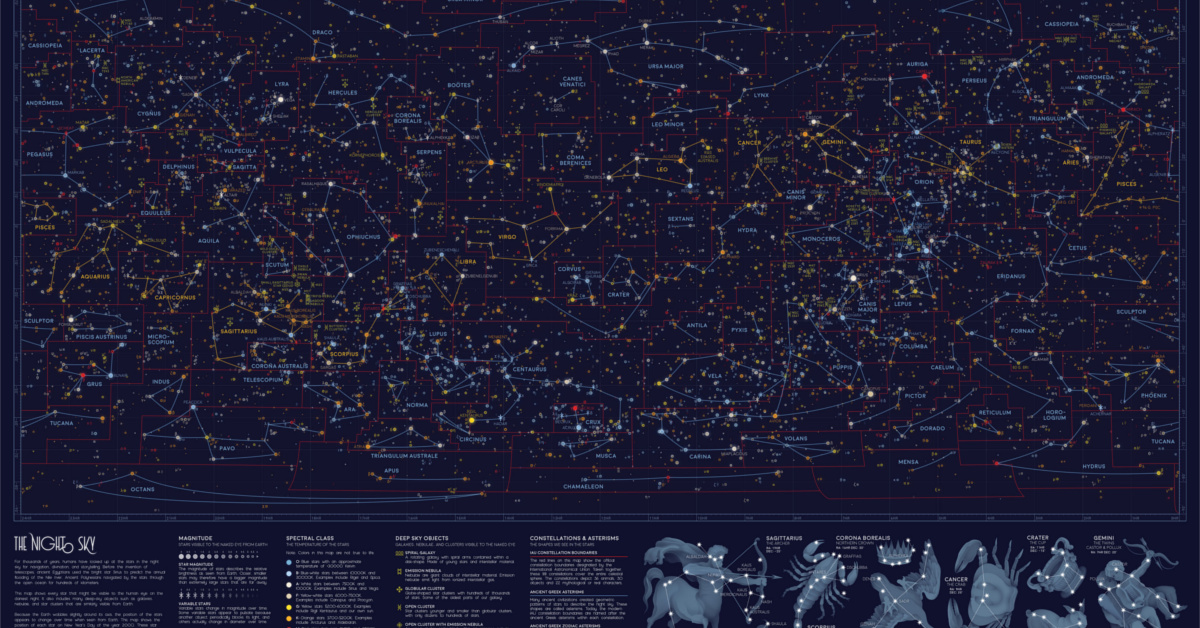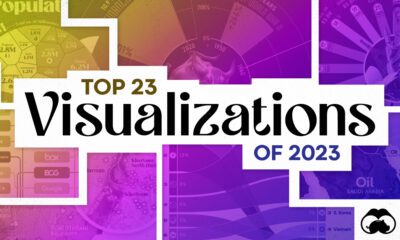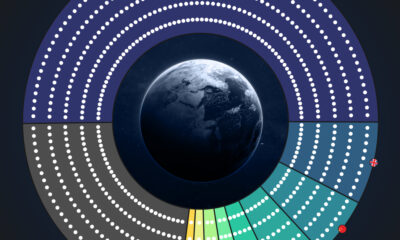Misc
Every Visible Star in the Night Sky, in One Map
View the full-size version of this infographic.
Every Visible Star in the Night Sky, in One Map
View the high resolution version of this incredible map by clicking here.
The stars have fascinated humanity since the beginning of civilization, from using them to track the different seasons, to relying on them to navigate thousands of miles on the open ocean.
Today, travelers trek to the ends of the Earth to catch a glimpse of the Milky Way, untouched by light pollution. However, if you’re in the city and the heavens align on a clear night, you might still be able to spot somewhere between 2,500 to 5,000 stars scattered across your field of vision.
This stunning star map was created by Eleanor Lutz, under the Reddit pseudonym /hellofromthemoon, and is a throwback to all the stars and celestial bodies that could be seen by the naked eye on Near Year’s Day in 2000.
Star Light, Star Bright
Stars have served as a basis for navigation for thousands of years. Polaris, also dubbed the North Star in the Ursa Minor constellation, is arguably one of the most influential, even though it sits 434 light years away.
Because of its relative location to the Earth’s axis, Polaris is reliably found in the same spot throughout the year—on this star map, it can be spotted in the top right corner. The Polynesian people famously followed the path of the North Star, along with wave currents, in all their way-finding journeys.
Interestingly, Polaris’ dependability is why it is commonly mistaken as the brightest star, but Sirius actually takes that crown—find it below the Gemini constellation, at the 7HR latitude and -20° longitude coordinates on the visualization. Located in the Canis Majoris constellation, Sirius burns bluish-white, and is one of the hottest objects in the universe with a surface temperature of 17,400°F (9,667°C). Sirius is nearly 40 times brighter than our Sun.
The Egyptians associated Sirius with the goddess Isis, and used its location to predict the annual flooding of the Nile. This also isn’t the only way humans have used visible stars to “predict” the future, as evidenced by the ancient practice of astrology.
Seeking Answers in the Stars
In the star map above, the orange lines denote the twelve signs of the Zodiac, each found roughly along the same band from 10° to -30° longitude. These Zodiac alignments, along with planetary movements, form the basis of astrology, which has been practiced across cultures to predict significant events. While the scientific method has widely demonstrated that astrology doesn’t hold much validity, many people still believe in it today.
The red lines on the visualization signify the constellations officially recognized by the International Astronomical Union (IAU) in 1922. Its ancient Greek origins are recorded on the same map as the blue lines, from which the modern constellation boundaries are based. Here’s a deeper dive into all 88 IAU constellations:
| Constellation | English Name | Category | Brightest star |
|---|---|---|---|
| Andromeda | Chained Maiden/ Princess | Creature/ Character | Alpheratz |
| Antlia | Air Pump | Object | α Antliae |
| Apus | Bird of Paradise | Animal | α Apodis |
| ♒ Aquarius | Water Bearer | Creature/ Character | Sadalsuud |
| Aquila | Eagle | Animal | Altair |
| Ara | Altar | Object | β Arae |
| ♈ Aries | Ram | Animal | Hamal |
| Auriga | Charioteer | Creature/ Character | Capella |
| Boötes | Herdsman | Creature/ Character | Arcturus |
| Caelum | Engraving Tool | Object | α Caeli |
| Camelopardalis | Giraffe | Animal | β Camelopardalis |
| ♋ Cancer | Crab | Animal | Tarf |
| Canes Venatici | Hunting Dogs | Animal | Cor Caroli |
| Canis Major | Great Dog | Animal | Sirius |
| Canis Minor | Lesser Dog | Animal | Procyon |
| ♑ Capricornus | Sea Goat | Creature/ Character | Deneb Algedi |
| Carina | Keel | Object | Canopus |
| Cassiopeia | Seated Queen | Creature/ Character | Schedar |
| Centaurus | Centaur | Creature/ Character | Rigil Kentaurus |
| Cepheus | King | Creature/ Character | Alderamin |
| Cetus | Sea Monster | Creature/ Character | Diphda |
| Chamaeleon | Chameleon | Animal | α Chamaeleontis |
| Circinus | Compass | Object | α Circini |
| Columba | Dove | Animal | Phact |
| Coma Berenices | Bernice's Hair | Creature/ Character | β Comae Berenices |
| Corona Australis | Southern Crown | Object | Meridiana |
| Corona Borealis | Northern Crown | Object | Alphecca |
| Corvus | Crow | Animal | Gienah |
| Crater | Cup | Object | δ Crateris |
| Crux | Southern Cross | Object | Acrux |
| Cygnus | Swan | Animal | Deneb |
| Delphinus | Dolphin | Animal | Rotanev |
| Dorado | Swordfish | Animal | α Doradus |
| Draco | Dragon | Creature/ Character | Eltanin |
| Equuleus | Little Horse | Animal | Kitalpha |
| Eridanus | River | Object | Achernar |
| Fornax | Furnace | Object | Dalim |
| ♊ Gemini | Twins | Creature/ Character | Pollux |
| Grus | Crane | Animal | Alnair |
| Hercules | Hercules | Creature/ Character | Kornephoros |
| Horologium | Pendulum Clock | Object | α Horologii |
| Hydra | Female Water Snake | Creature/ Character | Alphard |
| Hydrus | Male Water Snake | Creature/ Character | β Hydri |
| Indus | Indian | Creature/ Character | α Indi |
| Lacerta | Lizard | Animal | α Lacertae |
| ♌ Leo | Lion | Animal | Praecipua |
| Leo Minor | Lesser Lion | Animal | Regulus |
| Lepus | Hare | Animal | Arneb |
| Libra | Scales | Object | Zubeneschamali |
| Lupus | Wolf | Animal | α Lupi |
| Lynx | Lynx | Animal | α Lyncis |
| Lyra | Lyre | Object | Vega |
| Mensa | Table Mountain | Object | α Mensae |
| Microscopium | Microscope | Object | γ Microscopii |
| Monoceros | Unicorn | Creature/ Character | β Monocerotis |
| Musca | Fly | Animal | α Muscae |
| Norma | Carpenter's Square | Object | γ2 Normae |
| Octans | Octant | Object | ν Octantis |
| Ophiuchus | Serpent Bearer | Creature/ Character | Rasalhague |
| Orion | Hunter | Creature/ Character | Rigel |
| Pavo | Peacock | Animal | Peacock |
| Pegasus | Winged Horse | Creature/ Character | Enif |
| Perseus | Hero | Creature/ Character | Mirfak |
| Phoenix | Phoenix | Creature/ Character | Ankaa |
| Pictor | Painter's Easel | Object | α Pictoris |
| ♓ Pisces | Fishes | Animal | Alpherg |
| Piscis Austrinus | Southern Fish | Creature/ Character | Fomalhaut |
| Puppis | Stern | Object | Naos |
| Pyxis | Mariner's Compass | Object | α Pyxidis |
| Reticulum | Reticle (Eyepiece) | Object | α Reticuli |
| Sagitta | Arrow | Object | γ Sagittae |
| ♐ Sagittarius | Archer | Creature/ Character | Kaus Australis |
| ♏ Scorpius | Scorpion | Animal | Antares |
| Sculptor | Sculptor | Creature/ Character | α Sculptoris |
| Scutum | Shield | Object | α Scuti |
| Serpens | Serpent | Animal | Unukalhai |
| Sextans | Sextant | Object | α Sextantis |
| ♉ Taurus | Bull | Animal | Aldebaran |
| Telescopium | Telescope | Object | α Telescopii |
| Triangulum | Triangle | Object | Atria |
| Triangulum Australe | Southern Triangle | Object | β Trianguli |
| Tucana | Toucan | Animal | α Tucanae |
| Ursa Major | Great Bear | Animal | Alioth |
| Ursa Minor | Little Bear | Animal | Polaris |
| Vela | Sails | Object | γ2 Velorum |
| ♍ Virgo | Maiden | Creature/ Character | Spica |
| Volans | Flying Fish | Animal | β Volantis |
| Vulpecula | Fox | Animal | Anser |
(Source: International Astronomical Union)
Into the Depths of Deep Space
The quirk of naming stars after flora and fauna doesn’t end there. Our night sky also reveals visible galaxies, nebulae, and clusters far, far away—but they’re named after familiar birds, natural objects, and mythical creatures. See if you can find some of these interesting names:
- Open Cluster: Wild Duck Cluster
- Open Cluster: Eagle Nebula
- Open Cluster: Beehive Cluster
- Open Cluster: Butterfly Cluster
- Emission Nebula: North American
- Emission Nebula: Trifid Nebula
- Emission Nebula: Lagoon Nebula
- Emission Nebula: Orion Nebula
- Open Cluster with Emission Nebula: Swan Nebula
- Open Cluster with Emission Nebula: Christmas Tree Cluster
- Open Cluster with Emission Nebula: Rosette Nebula
- Globular Cluster: Hercules Cluster
There’s an interesting concentration of unnamed open and globular clusters just above the Sagittarius constellation, between 18-20HR latitude and -20° to -30° longitude. Another one can be seen next to Cassiopeia, just below Polaris between 1HR-3HR latitude, at 60° longitude. The only two visible spiral galaxies, Andromeda and Pinwheel, are located close between 0-2HR latitude and 30°-40° longitude.
The Relentless Passage of Time
We now know that the night sky isn’t as static as people used to believe. Although it’s Earth’s major pole star today, Polaris was in fact off-kilter by roughly 8° a few thousand years ago. Our ancestors saw the twin northern pole stars, Kochab and Pherkad, where Polaris is now.
This difference is due to the Earth’s natural axial tilt. Eight degrees may not seem like much, but because of this angle, the constellations we gaze at today are the same, yet completely different from the ones our ancestors looked up at.
If you liked exploring this star map, be sure to check out the geology of Mars from the same designer.
Politics
Charted: Trust in Government Institutions by G7 Countries
How much do you trust the government and its various institutions? We look at data for G7 countries for the time period of 2006-2023.
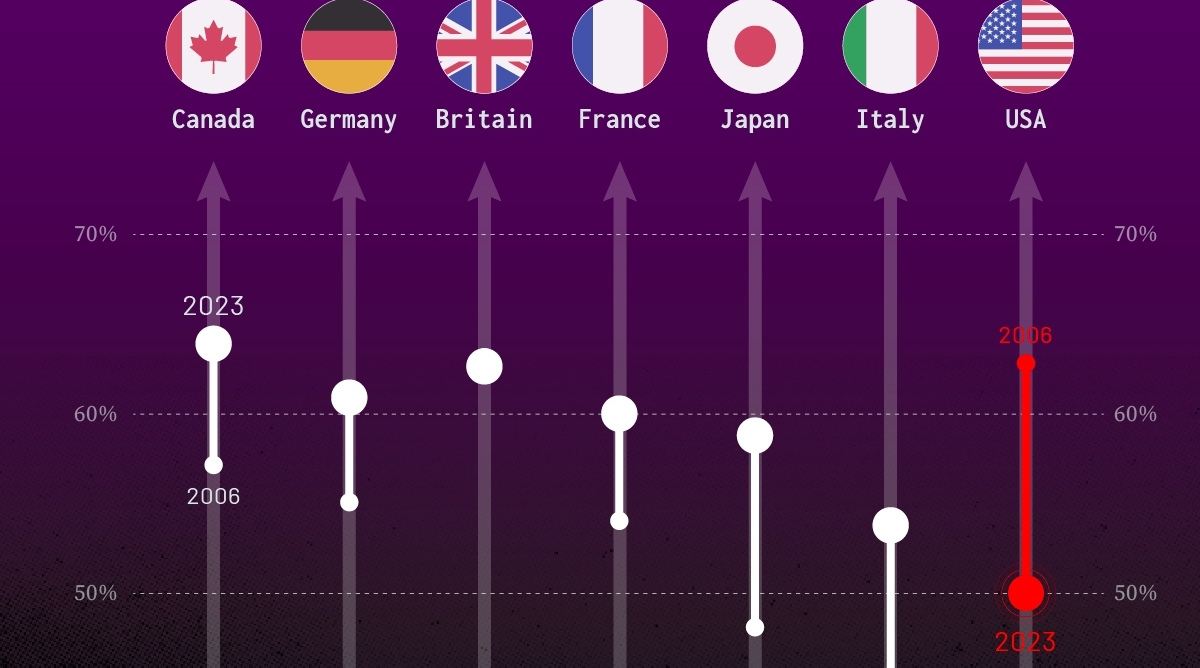
Trust in Government Institutions by G7 Countries
This was originally posted on our Voronoi app. Download the app for free on iOS or Android and discover incredible data-driven charts from a variety of trusted sources.
How much do you trust the government, and its various institutions?
It’s likely that your level of confidence probably depends on a wide range of factors, such as perceived competency, historical context, economic performance, accountability, social cohesion, and transparency.
And for these same reasons, trust levels in government institutions also change all the time, even in the world’s most developed countries: the G7.
Confidence in Government by G7 Countries (2006-2023)
This chart looks at the changes in trust in government institutions between the years 2006 and 2023, based on data from a multi-country Gallup poll.
Specifically, this dataset aggregates confidence in multiple national institutions, including the military, the judicial system, the national government, and the integrity of the electoral system.
| Country | Confidence (2006) | Confidence (2023) | Change (p.p.) |
|---|---|---|---|
| Canada | 57% | 64% | +7 |
| Britain | 63% | 63% | +0 |
| Germany | 55% | 61% | +6 |
| France | 54% | 60% | +6 |
| Japan | 48% | 59% | +11 |
| Italy | 41% | 54% | +13 |
| United States | 63% | 50% | -13 |
What’s interesting here is that in the G7, a group of the world’s most developed economies, there is only one country bucking the general trend: the United States.
Across most G7 countries, confidence in institutions has either improved or stayed the same between 2006 and 2023. The largest percentage point (p.p.) increases occur in Italy and Japan, which saw +13 p.p. and +11 p.p. increases in trust over the time period.
In the U.S., however, confidence in government institutions has fallen by 13 p.p. over the years. What happened?
Key Figures on U.S. Trust in Institutions
In 2006, the U.S. was tied with the UK as having the highest confidence in government institutions, at 63%.
But here’s where the scores stand in 2023, across various institutions:
| 🇺🇸 Institutions | Confidence (2023) |
|---|---|
| Military | 81% |
| Judiciary | 42% |
| National Government | 30% |
| Elections | 44% |
| Overall | 49% |
Based on this data, it’s clear that the U.S. lags behind in three key indicators: confidence in the national government, confidence in the justice system, and confidence in fair elections. It ranked in last place for each indicator in the G7.
One other data point that stands out: despite leading the world in military spending, the U.S. is only the third most confident in its military in the G7. It lags behind France (86%) and the United Kingdom (83%).
-

 Technology7 days ago
Technology7 days agoVisualizing AI Patents by Country
-

 Green2 weeks ago
Green2 weeks agoRanking the Top 15 Countries by Carbon Tax Revenue
-

 Markets2 weeks ago
Markets2 weeks agoU.S. Debt Interest Payments Reach $1 Trillion
-

 Mining2 weeks ago
Mining2 weeks agoGold vs. S&P 500: Which Has Grown More Over Five Years?
-

 Uranium2 weeks ago
Uranium2 weeks agoThe World’s Biggest Nuclear Energy Producers
-

 Misc2 weeks ago
Misc2 weeks agoHow Hard Is It to Get Into an Ivy League School?
-

 Debt2 weeks ago
Debt2 weeks agoHow Debt-to-GDP Ratios Have Changed Since 2000
-

 Culture2 weeks ago
Culture2 weeks agoThe Highest Earning Athletes in Seven Professional Sports

